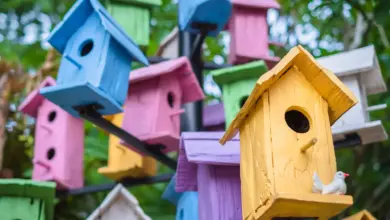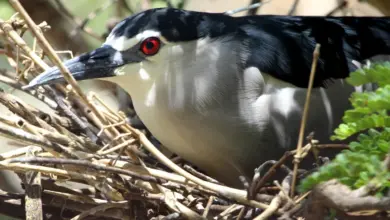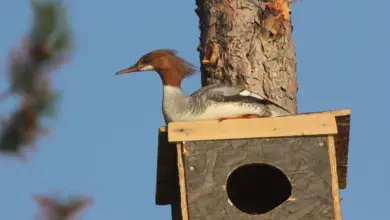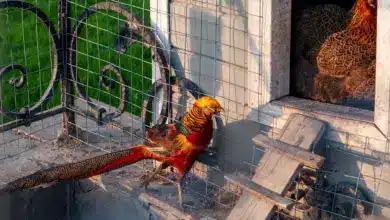When keeping pheasants, special attention should be paid to their accommodation. Aviaries need plenty of brush and bushes as pheasants are secretive nesters and build their nests on the ground.
The way breeding stock are housed is governed to a large extent by the size of the operation, the land available, and the type of market for which the pheasants are being reared.
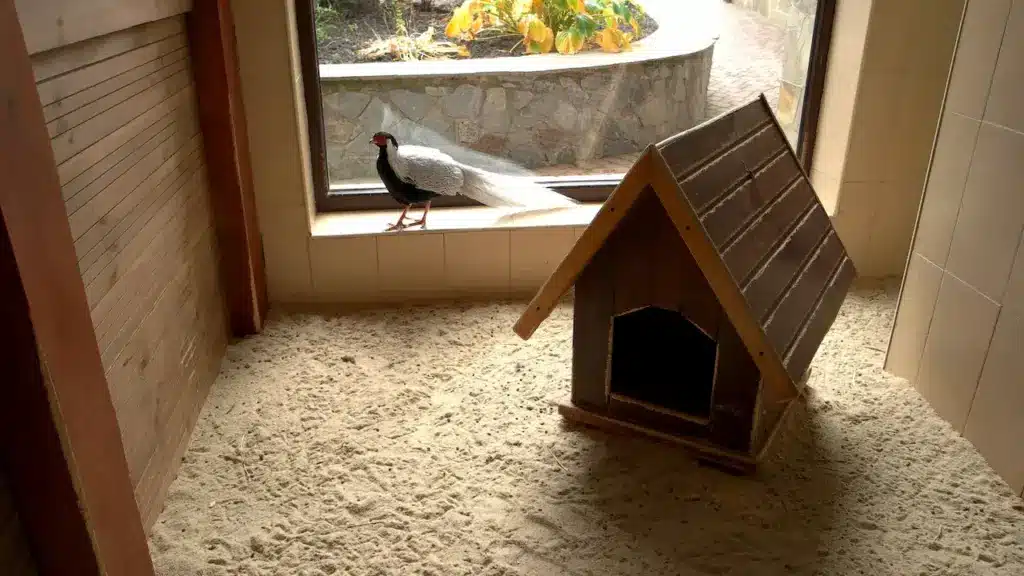
Range conditions
NSW Department of Primary Industries
- For range breeding, each bird needs about 6.5 ft. x 6.5 ft (2m x 2m) of ground space.
- The site chosen should be a dry, well-drained, sheltered area — green pasture is not required.
- Make sure there is good cover where hens can shelter from overzealous cocks. Good cover will also encourage hens to lay eggs at central points, preventing them from being scattered over the yard.
- Shelters should be strategically placed throughout the yard. The shelters shown have the approximate dimensions 5 ft x 3.3 ft (1.5 m × 1 m). Regularly place a small amount of feed in front of each shelter to encourage birds to use them. One shelter for every 40 hens is quite sufficient, provided there is also a reasonable amount of natural grass or brush cover. If there is no natural cover, branches from trees can be placed throughout the yard. Suitable protective cover can also be provided by native foliage or from cultivated crops.
- If cultivated crops are sown, a mixture of millet and sorghum grains is ideal. The variety of the grains sown should be those recommended for the district. Alternate strips of canola (rape) can be sown with the above grain mixture. The canola will provide greenfeed picking for the pheasants.
- Dry stubble paddocks are also ideal for growing stock. Cut a section of the growth to give the pheasants access to moveable shelter sheds.
- The only practical way to prevent hawks attacking pheasants is to cover the pens with wire netting or lightweight plastic mesh.
- A disadvantage of range breeding is that some eggs will be laid in places other than the set nesting areas, and these can be missed during egg collection. The large area makes egg collection a more difficult and more frequent job than with other systems.
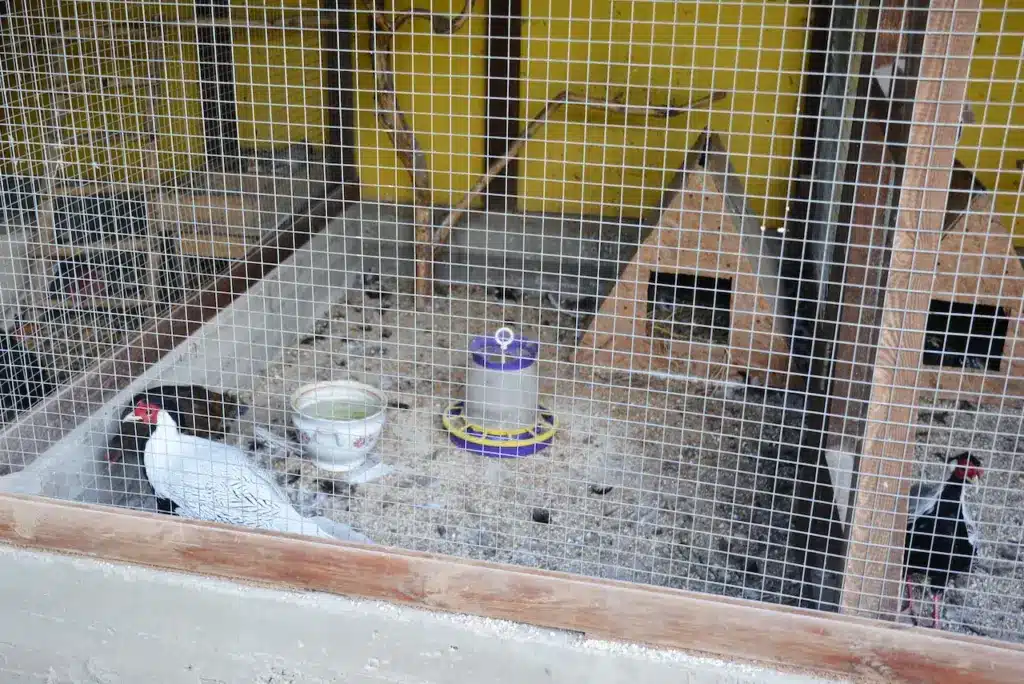
Intensive housing
Where breeders are housed intensively, skillion-roofed buildings are ideal. Place cage litter on the floor to a depth of about 4 inches (8 cm). Options are decomposed non-toxic saw dust, corn cob, wood shavings (i.e., Aspen shavings) or other suitable materials. Please note that wood shavings – such as pine, cedar and redwood – give off aromatic hydrocarbons (phenols) and acids that are toxic and can cause dermatitis, allergic symptoms and irritation of the digestive tract. They should not be used in cages, aviaries, or nestboxes. The larger the wood chips the better, so the parents don’t feed it to the babies or the chicks accidentally ingest it. Other options for nesting material include shredded news paper and clean straw / dried grass.
Give each breeder about 1.6 sq.ft (0.5 m2) of floor space, and house no more than 50 breeders in one shed.
The photo at right shows birds housed intensively on litter. Note the perches provided for the hens, and the hanging tube feeder and cone-shaped drinker.
- In each intensive breeding house, provide a shelter (similar to the type suggested for range breeders) and a few suitable bushy tree branches. It is also advisable to run three perches 16 inches (40 cm) apart, along either the back or side of the building. This will provide additional shelter where hens can get away from a cock if they do not wish to mate.
- Where breeder birds are housed under intensive conditions, it is essential that they be mated at least 4 weeks before the breeding season starts, otherwise it becomes virtually impossible to get the birds to settle down — cocks will be injured through fighting, less dominant males will not be allowed to mate, and fertility will be low.
- During bad weather, conditions in an intensive house can be controlled to a large extent by the use of blinds or shutters.
- Artificial lights can be installed to help maintain, control and adjust peak egg production, giving a much greater overall control of the breeding flock than under range conditions.
- Egg collection is easier.
- More accurate flock performance records can be kept. The records can include such factors as feed consumption, which should be lower than under range conditions due to better temperature control and the absence of wild birds and rodents.
NSW Department of Primary Industries
Aviary Size Requirements:
| Species | AviarySize | |
| Blood Pheasant | 150 sq ft / 4 sq m | |
| Blue-eared Pheasant | 200+ sq ft / 19+ sq.m | |
| Blyth’s Tragopan | 400 sq ft / 37 sq m | |
| Bronze-tailed Peacock-pheasant | 100+ sq ft / 9.3+ sq m | |
| Brown-eared Pheasant | 200+ sq ft / 19+ sq m | |
| Bulwer’s Wattled Pheasant | 200 sq ft / 18.6 sq m | |
| Cabot’s Tragopan | 400 sq ft / 37 sq m | |
| Cheer Pheasant | 200 sq ft / 18.6 sq m | |
| Congo Peafowl | 200 sq ft / 18.6 sq m | |
| Copper Pheasant | 200 sq ft / 18.6 sq m | |
| Edwards’ Pheasant | 150 sq ft / 14 sq m | |
| Elliot’s Pheasant | 200 sq ft / 18.6 sq m | |
| Germain’s Peacock-pheasant | 100-150 sq ft / 9.3-14 sq m | |
| Golden Pheasant | 100 sq ft / 9.3 sq m | |
| Green Junglefowl | 100+ sq ft / 9.3+ sq m | |
| Green Peafowl | 400 sq ft / 42 sq m | |
| Grey Peacock-pheasant | 100-150 sq ft / 9.3-14 sq m | |
| Himalayan Monal | 200 sq ft / 18.6 sq m | |
| Hume’s Pheasant | 200 sq ft / 18.6 sq m | |
| Imperial Pheasant | 150 sq ft / 14 sq m | |
| Indian Peafowl (Blue Peafowl) | 400+ sq ft / 37+ sq m | |
| Kalij Pheasant | 200 sq ft / 18.6 sq m | |
| Koklass Pheasant | 400 sq ft / 37 sq m | |
| La Fayette’s Junglefowl | 100-150 sq ft / 9.3-14 sq m | |
| Lady Amherst’s Pheasant | 100+ sq ft / 9.3+ sq m | |
| Lesser Bornean Crested Fireback | 1150-200 sq ft / 4-18.6 sq m | |
| Malay Crested Fireback | 150 sq ft / 14 sq m | |
| Malay Great Argus | 400 sq ft / 37 sq m | |
| Malay Peacock-pheasant | 100-150 sq ft / 9.3-14 sq m | |
| Mikado Pheasant | 200 sq ft / 18.6 sq m | |
| Molesworth’s Tragopan | 400 sq ft / 37 sq m | |
| Palawan Peacock-pheasant | 100 sq ft / 9.3 sq m | |
| Red Junglefowl | 100-150 sq ft / 9.3-14 sq m | |
| Reeve’s Pheasant | 200+ sq ft / 19+ sq m | |
| Rothschild’s Peacock-pheasant | 100-150 sq ft / 9.3-14 sq m | |
| Salvadori’s Pheasant | 150-200 sq ft / 14-18.6 sq m | |
| Satyr Tragopan | 400 sq ft / 37 sq m | |
| Siamese Fireback | 150-200 sq ft / 14-18.6 sq m | |
| Silver Pheasant | 100-200 sq ft / 9.3-18.6 sq m | |
| Sonnerat’s Junglefowl | 100-200 sq ft / 9.3-18.6 sq m | |
| Swinhoe’s Pheasant | 150-200 sq ft / 14-18.6 sq m | |
| Szechuan White-eared Pheasant | 200 sq ft / 18.6 sq m | |
| Temminck’s Tragopan | 400 sq ft / 37 sq m | |
| Vietnamese Pheasant | 150 sq ft / 14 sq m | |
| Western Tragopan | 400 sq ft / 37 sq m |
